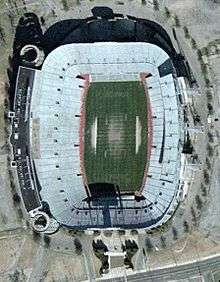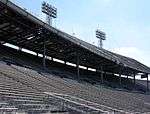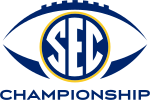Legion Field
|
"Football Capital of the South" "Old Gray Lady" | |
|
| |
| Location |
400 Graymont Avenue West Birmingham, Alabama 35204 |
|---|---|
| Coordinates | 33°30′41″N 86°50′34″W / 33.51139°N 86.84278°WCoordinates: 33°30′41″N 86°50′34″W / 33.51139°N 86.84278°W |
| Owner | City of Birmingham |
| Operator | University of Alabama at Birmingham |
| Capacity | 71,594 |
| Surface |
FieldTurf (2006–present) Grass (1927–1969, 1995–2005) AstroTurf (1975–1994) PolyTurf (1970–1974) |
| Construction | |
| Broke ground | 1926 |
| Opened | November 19, 1927[1] |
| Renovated | 1961, 1965, 2005, 2015[2] |
| Expanded | 1934, 1948, 1961, 1965, 1977, 1991 |
| Construction cost | $439,000 USD |
| Architect | D.O. Whilldin |
| Tenants | |
|
Alabama Crimson Tide (NCAA) (1927–2003) Auburn Tigers (NCAA) (1926–1991) UAB Blazers (NCAA) (1991–2014, 2017–present) Birmingham Bowl (NCAA) (2006–present) Birmingham Americans (WFL) (1974) Birmingham Vulcans (WFL) (1975) Alabama Vulcans (AFA) (1979) Birmingham Stallions (USFL) (1983–1985) Birmingham Fire (WLAF) (1991–1992) Birmingham Barracudas (CFL) (1995) Birmingham Thunderbolts (XFL) (2001) Dixie Bowl (NCAA) (1948–1949) All-American Bowl (NCAA) (1977–1990) Birmingham Iron (AAF) (2019–) | |
Legion Field is a stadium in Birmingham, Alabama, United States, primarily designed to be used as a venue for American football, but occasionally used for other large outdoor events. The stadium opened in 1927 and is named in honor of the American Legion, a U.S. organization of military veterans. Since the 2004 removal of the upper deck, Legion Field seats approximately 71,594 spectators. At its peak it seated 83,091 people for football and had the name "Football Capital of the South" emblazoned from the facade on its upper deck. Legion Field is colloquially called "The Old Gray Lady" and "The Gray Lady on Graymont". The stadium's current primary tenant are the University of Alabama at Birmingham Blazers, a member of Conference USA.
Stadium history
Construction of a 21,000 seat stadium began in 1926 at the cost of $439,000. It was completed in 1927 and named Legion Field in honor of the American Legion. In the stadium's first event, 16,800 fans watched Howard College (now known as Samford University) shut out Birmingham–Southern College 9–0 on November 19, 1927.
Over the years, the stadium grew. The expansions didn't follow the designer's initial intent on the stadium becoming a monumental horseshoe-shaped amphitheater.[3] Capacity was increased to 25,000 in 1934 and to 45,000 in 1948, and the bowl was enclosed. In 1961, a 9,000 seat upper deck was added to the east side of the stadium, increasing capacity to 54,600. In 1965, a new press box was built in the stadium and capacity was further increased to 68,821. The first nationally televised night college football game at Legion Field was between Ole Miss and Alabama on October 4, 1969.[4]
In 1970, the natural grass turf was replaced with Poly-Turf, which in turn was replaced by AstroTurf in 1975. Seating capacity was increased to 75,808 in 1977 and further increased to 83,091 in 1991. The turf was changed to back to a natural Bermuda grass surface in 1995 in order to host soccer events for the Summer Olympics taking place in Atlanta.[5] In 2006, the field went back to an artificial surface, the next-generation FieldTurf.
In 2004, a structural evaluation determined that the 9,000 seat upper deck would need major remediation to meet modern building codes. With little prospect of adequate repairs on the way, the University of Alabama withdrew the few home games it still scheduled for Birmingham.[6] The city removed the upper deck in 2005 since the capacity was greater than the need for its tenants. In 2015, renovations took place including general improvements and overall renovations including a new and larger video scoreboard along with a new and improved sound system.
Football
UAB Blazers
Legion Field served as the home field of the UAB Blazers, members of Conference USA, since 1991. The Blazer temporarily left Legion Field without a primary tenant during the school's two-year hiatus from football.[7] The Blazers returned to Legion Field for the first time in two years on September 2, 2017, setting a new attendance record in a 38-7 victory over Alabama A&M.[8]
Iron Bowl
Legion Field was well known for hosting the regular season-ending rivalry game between Alabama and Auburn each year from 1948 to 1988. Because of Birmingham's major industry of iron and steel manufacturing, the game became known as the "Iron Bowl." From the series' resumption in 1948 to 1987, each team rotated claiming home-field rights. Tickets were split equally between the two athletic departments to sell, similar to other rivalries like the Red River Shootout between Oklahoma and Texas. In 1989, Auburn decided to move their home games in the series to Jordan–Hare Stadium, therefore the tickets were no longer split equally. Auburn played their last Iron Bowl home game at Legion Field in 1991. In 2000, Alabama followed suit and decided to no longer play their home games against Auburn at Legion Field. Alabama holds a 32–15 advantage over Auburn in games played at Legion Field.
Other Alabama and Auburn football games
Due to its size and location, both Alabama and Auburn used Legion Field as an alternate home stadium for much of the 20th century. Between its use for the Iron Bowl and as an alternate home stadium for the Crimson Tide and Tigers, Legion Field played host to many of the most important football games in Alabama's history.
Well into the 1980s, Alabama played most of its important games, as well as the Iron Bowl, at Legion Field—to the point that most of Alabama's "home" football history from the 1920s to the 1980s took place in Birmingham.[9] At its height, it seated 20,000 more people than the Tide's on-campus stadium, Bryant–Denny Stadium. Additionally, Birmingham was more accessible than Tuscaloosa for much of the 20th century—even though Tuscaloosa is only 45 minutes west of Birmingham. The Crimson Tide hosted Tennessee in odd-numbered years in Birmingham until 1998, and hosted LSU in even-numbered years from 1964 through 1986, except for 1980. Alabama also played its entire 1987 home schedule at Legion Field due to major renovations at Bryant–Denny Stadium. Indeed, the stadium's strong association with Alabama football led Auburn to lobby to have its home games in the Iron Bowl played in Auburn.
Until 1998, Alabama played at least three games at Legion Field every season. In 1998, Alabama double-decked the east stands at Bryant-Denny, bringing its capacity to a few hundred more seats than that of Legion Field. Due to the disrepair of Legion Field and the added capacity in Tuscaloosa, Alabama moved major conference games on campus. In the ensuing years, Alabama decreased the number of games scheduled in Birmingham. The last home game for Alabama at Legion Field was against the University of South Florida on August 30, 2003. Though Alabama had a couple of games scheduled at Legion Field in 2005 and 2008, the stadium's poor state of repair (see above) led Alabama to end its contract with the city of Birmingham in 2004 and move all home games to Tuscaloosa. [10]
Auburn also used Legion Field for some home games well into the 1970s due to the larger capacity and the difficulty in traveling to Auburn for most of the 20th century. Auburn played all home games against Tennessee at Legion Field until 1978, except in 1974, when the game was played in Auburn.[11] Auburn also played all home games against Georgia Tech at Legion Field until 1970. Auburn played its last home game at Legion Field in 1991, but took part in the Birmingham Bowl at the same stadium in 2015 as a postseason bowl game.
Other football games
Legion Field has hosted a number of other college football games. The annual Magic City Classic between Alabama A&M University and Alabama State University has been played here since 1946. The Steel City Classic featuring Miles College and Stillman College is also played at Legion Field. The MEAC/SWAC Challenge was played at Legion Field from 2005 to 2007, but moved to Orlando in 2008.
Birmingham–Southern College played against Mississippi College's junior varsity team in Legion Field on September 6, 2007, in their first football game since 1939.
In terms of postseason play, the Southwestern Athletic Conference used the stadium for their conference championship from 1999 to 2012, but moved to Houston's NRG Stadium in 2013. The Southeastern Conference played their first two conference title games here in 1992 and 1993.
This stadium has also hosted four different bowl games in its history:
- Dixie Bowl (1947–48)
- Hall of Fame Bowl (1977–1985) This game moved to Tampa, Florida in 1986 and was renamed the Outback Bowl in 1995.
- All-American Bowl (1986–1990)
- Birmingham Bowl (2006–current)
Professional football
Legion Field has served as the home stadium for various professional football teams in Birmingham. It served as home field for the Birmingham Americans (1974) and Birmingham Vulcans (1975) of the World Football League (1974–1975), the Alabama Vulcans of the American Football Association (1979), the Birmingham Stallions of the United States Football League (1983–1985), and the Birmingham Fire of the World League of American Football (later NFL Europe) in 1991–92. In 1995, it was the home field of the Birmingham Barracudas for their single season of play as part of the short-lived expansion of the Canadian Football League into the United States. In 2001, it was the home field for the single season of the Birmingham Thunderbolts of the XFL. There have also been at least two NFL preseason games here, on August 8, 1970 when the New York Jets defeated the Buffalo Bills 33-10, and on August 27, 1988 when the Washington Redskins defeated the Atlanta Falcons 34–17. Currently, it is slated to be the home field for the Birmingham Iron of the Alliance of American Football beginning in February 2019.
In 1968, the Boston Patriots of the American Football League played one "home" game against the New York Jets at Legion Field. The Jets, featuring former Alabama quarterback Joe Namath, won the game 47–31.[12]
High school football
Legion Field has hosted various high school football games throughout its history. From 1996 until 2008, Legion Field was used by the Alabama High School Athletic Association for the Super Six high school football championships.
Soccer
Legion Field had been used successfully as a site for major soccer events, including preliminary matchups in the 1996 Summer Olympics – the opening match between the United States and Argentina drew 83,810 spectators, the stadium's all-time record for any event. All of the concluding-round soccer games moved to Athens, Georgia after preliminary games had been played in various other cities.
Legion Field had also hosted exhibition games by the U.S. men's and women's national soccer teams, and in 2005 it hosted a World Cup qualifier between the U.S. and Guatemala.
When the City of Birmingham changed back to an artificial turf field in 2006, the United States Soccer Federation announced that it will no longer be scheduling men's national team games for playing in Legion Field.
1996 Olympic Soccer Men's tournament matches
| Date | Time (CDT) | Team #1 | Score | Team #2 | Round | Attendance |
|---|---|---|---|---|---|---|
| July 20, 1996 | 6:30 p.m. | 1–3 | Group A | 83,183 | ||
| July 21, 1996 | 4:00 p.m. | 1–0 | Group C | 44,211 | ||
| July 22, 1996 | 6:30 p.m. | 2–0 | Group A | 45,687 | ||
| July 23, 1996 | 7:00 p.m. | 0–0 | Group C | 26,111 | ||
| July 24, 1996 | 6:30 p.m. | 1–1 | Group A | 16,826 | ||
| July 25, 1996 | 8:00 p.m. | 2–1 | Group C | 28,319 |
1996 Olympic Soccer Women's tournament matches
| Date | Time (CDT) | Team #1 | Score | Team #2 | Round | Attendance |
|---|---|---|---|---|---|---|
| July 21, 1996 | 12:30 p.m. | 3–2 | Group B | 44.211 | ||
| July 23, 1996 | 3:30 p.m. | 2–0 | 26.111 | |||
| July 25, 1996 | 5:30 p.m. | 1–1 | 28.319 |
Concerts and other events
Legion Field has also been used as a concert venue, hosting famous artists of many different genres, including U2, Ruben Studdard, Pink Floyd, and The Rolling Stones.
In 1979 and 1980, the facility played host to the Drum Corps International World Championships.
The opening and closing ceremonies for the 2021 World Games will be held at Legion Field.
Gallery
 Old Legion Field Scoreboard
Old Legion Field Scoreboard Exterior View from Graymont Avenue
Exterior View from Graymont Avenue Satellite image taken in January 2004
Satellite image taken in January 2004- Satellite image taken in January 2015
 Photo of the stadium before the upper deck was demolished.
Photo of the stadium before the upper deck was demolished.
See also
References
- Notes
- ↑ http://bonesville.net/Articles/AlMyatt/2007/08/080207_Myatt.htm
- ↑ http://football.ballparks.com/NCAA/ConfUSA/AlabamaBirmingham/index.htm
- ↑ "New stadiums: Old Gray Lady and others" (September 25, 2015) StadiumDB.com
- ↑ "History Fades Away at Legion Field" (November 5, 2004)ESPN
- ↑ 1996 Summer Olympics official report. Volume 1. p. 541.
- ↑ "Alabama forced to abandon unsafe Legion Field" (August 19, 2003) Associated Press
- ↑ "UAB shuts down its football program", USA Today, 2014-12-02, retrieved 2014-12-02
- ↑ "UAB sets new attendance record in return game vs. Alabama A&M". AL.com. Retrieved 2017-09-19.
- ↑ "Alabama Football At Legion Field" (PDF). 2010 Alabama Football Media Guide. University of Alabama Athletic Department. pp. 141–142. Archived from the original (PDF) on May 23, 2011. Retrieved February 3, 2011.
- ↑ "Archived copy". Archived from the original on 2013-01-06. Retrieved 2012-12-05.
- ↑ College Football Data Warehouse, Auburn vs Tennessee. Archived January 15, 2015, at the Wayback Machine. Retrieved November 5, 2016.
- ↑ "Archived copy". Archived from the original on 2007-10-10. Retrieved 2009-09-15.
External links
- Legion Field at City of Birmingham official website
- UAB Athletics
- Legion Field Seating Chart
- Bhamwiki.com Legion Field article
| Events and tenants | ||
|---|---|---|
| Preceded by first stadium |
Host of Birmingham Bowl 2006 – present |
Succeeded by current |
| Preceded by first stadium |
Host of SWAC Championship Game 1999 – present |
Succeeded by current |
| Preceded by first stadium |
Host of SEC Championship Game 1992–1993 |
Succeeded by Georgia Dome |
| Preceded by first stadium |
Host of Dixie Bowl 1947–1948 |
Succeeded by defunct |
| Preceded by first stadium |
Host of Hall of Fame (Outback) Bowl 1977–1985 |
Succeeded by Tampa Stadium |
| Preceded by continuation after departure of Hall of Fame (Outback) Bowl |
Host of All-American Bowl 1986–1990 |
Succeeded by defunct |
| Preceded by Mile High Stadium |
Host of the Drum Corps International World Championship 1979–1980 |
Succeeded by Olympic Stadium (Montreal) |


